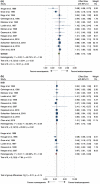The association of impaired semen quality and pregnancy rates in assisted reproduction technology cycles: Systematic review and meta-analysis
- PMID: 35244232
- PMCID: PMC9540664
- DOI: 10.1111/and.14409
The association of impaired semen quality and pregnancy rates in assisted reproduction technology cycles: Systematic review and meta-analysis
Abstract
Some studies suggest a relationship between semen quality and pregnancy rates of assisted reproduction technologies (ART). Others have questioned the utility of semen quality as proxy for fertility in couples attempting to conceive with or without assistance. We aimed to investigate the current body of evidence which correlates semen parameters and clinical pregnancy among couples utilizing ART (i.e. in vitro fertilization [IVF], intracytoplasmic sperm injection [ICSI]) through a systematic review and meta-analysis of cross-sectional and retrospective cohort studies. Pooled Odd Ratio (OR) for oligo-, astheno- and teratospermic compared to normospermic number of ART cycles were calculated among. Meta-regression and sub-group analysis were implemented to model the contribution of clinical/demographic and laboratory standards differences among the studies. Overall, 17 studies were analysed representing 17,348 cycles were analysed. Pooled OR for impaired sperm concentration, motility and morphology was 1 (95%Confidence Interval [CI]: 0.97-1.03), 0.88 (95%CI: 0.73-1.03) and 0.88 (95%CI: 0.75-1) respectively. Further analysis on sperm morphology showed no differences with regard of IVF versus ICSI (p = 0.14) nor a significant correlation with rising reference thresholds (Coeff: -0.02, p = 0.38). A temporal trend towards a null association between semen parameters and clinical pregnancy was observed over the 20-year observation period (Coeff: 0.01, p = 0.014). The current analysis found no association between semen quality (as measured by concentration, motility or morphology) and clinical pregnancy rates utilizing ART. Future investigations are necessary to explore the association between semen parameters and other ART outcomes (e.g. fertilization, implantation, birth and perinatal health).
Keywords: ART cycles; ICSI; IVF; assisted reproductive technologies; semen parameters.
© 2022 The Authors. Andrologia published by Wiley-VCH GmbH.
Conflict of interest statement
Authors have no conflict of interest to disclose.
Figures



References
-
- Boeri, L. , Belladelli, F. , Capogrosso, P. , Cazzaniga, W. , Candela, L. , Pozzi, E. , Valsecchi, L. , Papaleo, E. , Viganò, P. , Abbate, C. , Pederzoli, F. , Alfano, M. , Montorsi, F. , & Salonia, A. (2021) Normal sperm parameters per se do not reliably account for fertility: A case‐control study in the real‐life setting. Andrologia, 53(1), 10.1111/and.13861 - DOI - PubMed
-
- Capelouto, S. M. , Nagy, Z. P. , Shapiro, D. B. , Archer, S. R. , Ellis, D. P. , Smith, A. K. , Spencer, J. B. , & Hipp, H. S. (2018). Impact of male partner characteristics and semen parameters on in vitro fertilization and obstetric outcomes in a frozen oocyte donor model. Fertility and Sterility, 110(5), 859–869. 10.1016/j.fertnstert.2018.06.003 - DOI - PubMed

